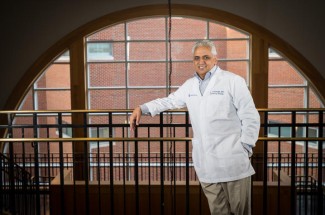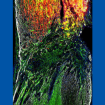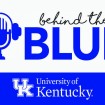UK neurologist advocates for AI, ultrasound to help prevent blindness from giant cell arteritis

A recently published article by UK HealthCare’s Jagannadha (Jay) Avasarala, M.D., Ph.D., professor of neurology, outlines the promise of point of care ultrasound (POCUS) in the diagnosis of Giant Cell Arteritis (GCA). Misdiagnosis or a missed diagnosis of GCA can result in blindness that is preventable. Avasarala’s recent article published in the Journal of Rheumatology calls for a rapid, “on-the-spot” diagnosis and treatment as the only way forward to prevent blindness caused by the disease. Since GCA is linked to aortic diseases, a diagnosis of GCA could lead to a search for aortic diseases that may be silent.
GCA is an inflammation of the lining of the arteries. Most frequently, it affects the arteries in the head, particularly those in the temples. For this reason, GCA is sometimes called temporal arteritis. The condition frequently causes headaches, scalp tenderness, jaw pain and vision problems but the key to diagnosis is that any new eye symptom at or above the age of 50 can signal the onset of GCA. Delay in treatment can lead to blindness and prompt treatment with IV corticosteroids usually relieves symptoms and can help prevent loss of vision. Unfortunately, once the damage is done and vision loss occurs, it is usually permanent.
GCA is the most common autoimmune systemic vasculitis of older adults and affects more women than men. About 20% of patients become blind or visually impaired due to misdiagnosis/delayed diagnosis. It is estimated that by 2050, three million people worldwide will be diagnosed with GCA and half a million of those are projected to become visually impaired or blind.
Currently, there are no standardized guidelines for healthcare providers that recommend a specific pathway to use ultrasound as a screening tool for patients with symptoms suggestive of GCA. There also is not currently a protocol for prevention of blindness in GCA across Europe or North America. Avasarala believes a universal practice based on a centralized cloud-based data collection system modeled from POCUS data acquisition and an artificial intelligence (AI)-driven diagnostic platform that provides instantaneous results for a clinician are urgently needed to prevent blindness.
Avasarala, director of the Multiple Sclerosis and Neuroimmunology Center within UK HealthCare’s Kentucky Neuroscience Institute, is believed to be the first researcher and physician to outline this novel concept. He believes that combining POCUS with AI algorithms could lead to a quick diagnosis for patients and their providers.
“The disease is not new; the approach to an instant diagnosis using POCUS has been done in other diseases, but not in GCA and certainly not on a global scale,” said Avasarala. “Considering that POCUS and AI-driven diagnostics already exist and are in use, it is shocking that we are not doing it for GCA since the consequences of delay are blindness or death from stroke/aortic disease. The need to standardize GCA diagnosis is urgent.”
According to the World Health Organization (WHO), vision impairment severely impacts the quality of life among adult populations. Adults with vision impairment may experience lower rates of employment and higher rates of depression and anxiety. In the case of older adults, vision impairment can contribute to social isolation, difficulty walking, a higher risk of falls and a greater likelihood of early entry into nursing or care homes.
Avasarala believes combining POCUS with AI, in some ways akin to what Viz.AI does, could have huge benefits. Viz.AI is a state-of-the-art and U.S. Food and Drug Administration (FDA)-cleared AI-based technology used in stroke care. The technology can auto-detect large vessel occlusion strokes. Its platform leverages FDA-cleared algorithms to analyze medical images and data, echocardiogram and electrocardiograms to accelerate diagnosis and treatment. “It is time to move GCA to a ‘stroke of the eye’ category or risk blindness in a significant percentage of patients due to delayed treatment or diagnosis,” writes Avasarala. This is unacceptable in this day and age, he says.
He explains in his article how the widespread commercial availability of handheld probes and pocket ultrasound transducers makes it feasible to acquire images at the bedside across many clinical scenarios. Since the devices possess the capability to synchronize and upload images to web-based cloud servers compliant with HIPAA, real-time feedback is possible. Avasarala says because of this the tool can be used anywhere — from an ambulance to out in the field — and image interpretation, specifically in underserved areas, can be instantaneous, based on AI algorithms.
“There is no reason why POCUS combined with AI algorithms cannot do the trick for GCA,” said Avasarala. “The goal is to save patients from becoming blind. An instant diagnosis of GCA is the only way to prevent blindness.”
Avasarala is working with leaders in both the ultrasound and AI field to make this concept a reality. “It has a long way to go, but is promising,” he said.




